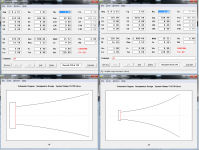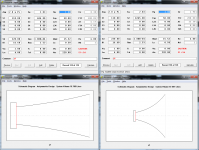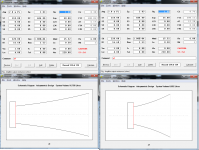Hi guys,
I thought I understood the basics of CD horns but there's something I clearly don't understand.
The rule of thumb is: if you want to cover lower frequencies you need a bigger horn. For example: Faital LTH102 in theory is good down to 1kHz and is 17cm deep. Faital LTH142 is good down to 800Hz and is 23 cm deep (and wider comparing to the former).
And now we have this: Beyma TD/385
HORN TD/385
It's quite small and only 12 cm deep. Still cut-off FQ is 800Hz an if you look at the response curve of CD14Fe coupled with that horn you would find it quite impressive:
SPEAKER DRIVER CD14Fe 8 OH
So it is small and shallow and seem to work. Are there any downsides? Or maybe even some advantages (less horn colouration?)
What am I missing?
I thought I understood the basics of CD horns but there's something I clearly don't understand.
The rule of thumb is: if you want to cover lower frequencies you need a bigger horn. For example: Faital LTH102 in theory is good down to 1kHz and is 17cm deep. Faital LTH142 is good down to 800Hz and is 23 cm deep (and wider comparing to the former).
And now we have this: Beyma TD/385
HORN TD/385
It's quite small and only 12 cm deep. Still cut-off FQ is 800Hz an if you look at the response curve of CD14Fe coupled with that horn you would find it quite impressive:
SPEAKER DRIVER CD14Fe 8 OH
So it is small and shallow and seem to work. Are there any downsides? Or maybe even some advantages (less horn colouration?)
What am I missing?
You are comparing horn lengths, which may not be helpful. The length can change depending on where you choose to start and to end the horn. Then there are different types of horn.
Perhaps you could get a copy of hornresp.exe and design a few to get a feel of what sets the cutoff. Also watch the directivity (beamwidth) to see how they differ in other ways.
Perhaps you could get a copy of hornresp.exe and design a few to get a feel of what sets the cutoff. Also watch the directivity (beamwidth) to see how they differ in other ways.
Possibly. The throat still exists to load the driver over some range. The shortened mouth may result in overall axial resonance at lower frequencies with features particularly at standing wave dimensions. The directivity may suffer from narrowing or widening within a certain range.
Correct me someone if I'm mistaken, but horn length is not necessarily related to cutoff frequency. Take a Tractrix and an OS wg of the same mouth size, the OS will provide slightly lower cutoff frequency even though it is much shorter. The tradeoff is that the flare rate is greater at the throat end in the OS. Hence it will have broader dispersion in the high frequencies and resulting lower efficiency. Likewise the higher flare at the mouth of the Tractrix will spread the lower frequencies more and hence compromise low frequency efficiency and apparent cutoff. To simplify, it's not about length, but about the flare angle at the point in the horn which is loading that particular frequency. High frequencies loaded at throat, low frequencies loaded at mouth.
With the tractrix and related horns you can choose to start or end the horn where you like and it can still have a given cutoff. This is connected to the flare rate. The directivity isn't necessarily the primary concern, although it may be, and it varies with frequency. Loading can also affect the output of the horn beyond the concentration provided by directivity.
The OS doesn't have a cutoff frequency as such. What it could be said to have is a frequency down to which it provides directional support before it was chosen to terminate the waveguide. This isn't connected to loading like with some horns.
The OS doesn't have a cutoff frequency as such. What it could be said to have is a frequency down to which it provides directional support before it was chosen to terminate the waveguide. This isn't connected to loading like with some horns.
I like to consider OS and conical to be the same in the bigger picture.
I also agree with your second statement because conical horns don't have a flare rate as such, since the flare angle doesn't change. Loading falls where it may based on the basic dimensions, and also in the sense that it isn't the primary concern.
I also agree with your second statement because conical horns don't have a flare rate as such, since the flare angle doesn't change. Loading falls where it may based on the basic dimensions, and also in the sense that it isn't the primary concern.
Last edited:
Thanks Allen.
Like the OP, for years I tried to figure out what determines the horn cutoff frequency. Looking at specs of horns I owned and those I could find docs for, didn't seem to help. Horns of very different mouth sizes and/or lengths might be listed as having the same cutoff frequency or recommended range.
The only parameter I found consistent was in Hornrsp. With a given profile, making the horn longer lowered the cutoff frequency.
Like the OP, for years I tried to figure out what determines the horn cutoff frequency. Looking at specs of horns I owned and those I could find docs for, didn't seem to help. Horns of very different mouth sizes and/or lengths might be listed as having the same cutoff frequency or recommended range.
The only parameter I found consistent was in Hornrsp. With a given profile, making the horn longer lowered the cutoff frequency.
Hi guys,
I thought I understood the basics of CD horns but there's something I clearly don't understand.
The rule of thumb is: if you want to cover lower frequencies you need a bigger horn. For example: Faital LTH102 in theory is good down to 1kHz and is 17cm deep. Faital LTH142 is good down to 800Hz and is 23 cm deep (and wider comparing to the former).
And now we have this: Beyma TD/385
HORN TD/385
It's quite small and only 12 cm deep. Still cut-off FQ is 800Hz an if you look at the response curve of CD14Fe coupled with that horn you would find it quite impressive:
SPEAKER DRIVER CD14Fe 8 OH
So it is small and shallow and seem to work. Are there any downsides? Or maybe even some advantages (less horn colouration?)
What am I missing?
- The cutoff of a horn is dictated by the DEPTH of a horn. For instance, a horn that's 8.5cm deep has a cutoff of approximately 1000hz
- Note that the pathlength begins at the diaphragm, not the throat
- When the wavelength exceeds the diameter, directivity narrows then widens. Note that this isn't unique to waveguides; it applies to ALL radiators. Cones, domes, ribbons, waveguides. The secondary flare on good horns and waveguides is there to address the narrowing.
- By making the chamber for your tweeter or woofer too small, you can extend the low frequency F3 and increase power handling. See "reactance annulling" and "qb5 alignments."
- Status
- This old topic is closed. If you want to reopen this topic, contact a moderator using the "Report Post" button.
- Home
- Loudspeakers
- Multi-Way
- can sb explain how this horn works


